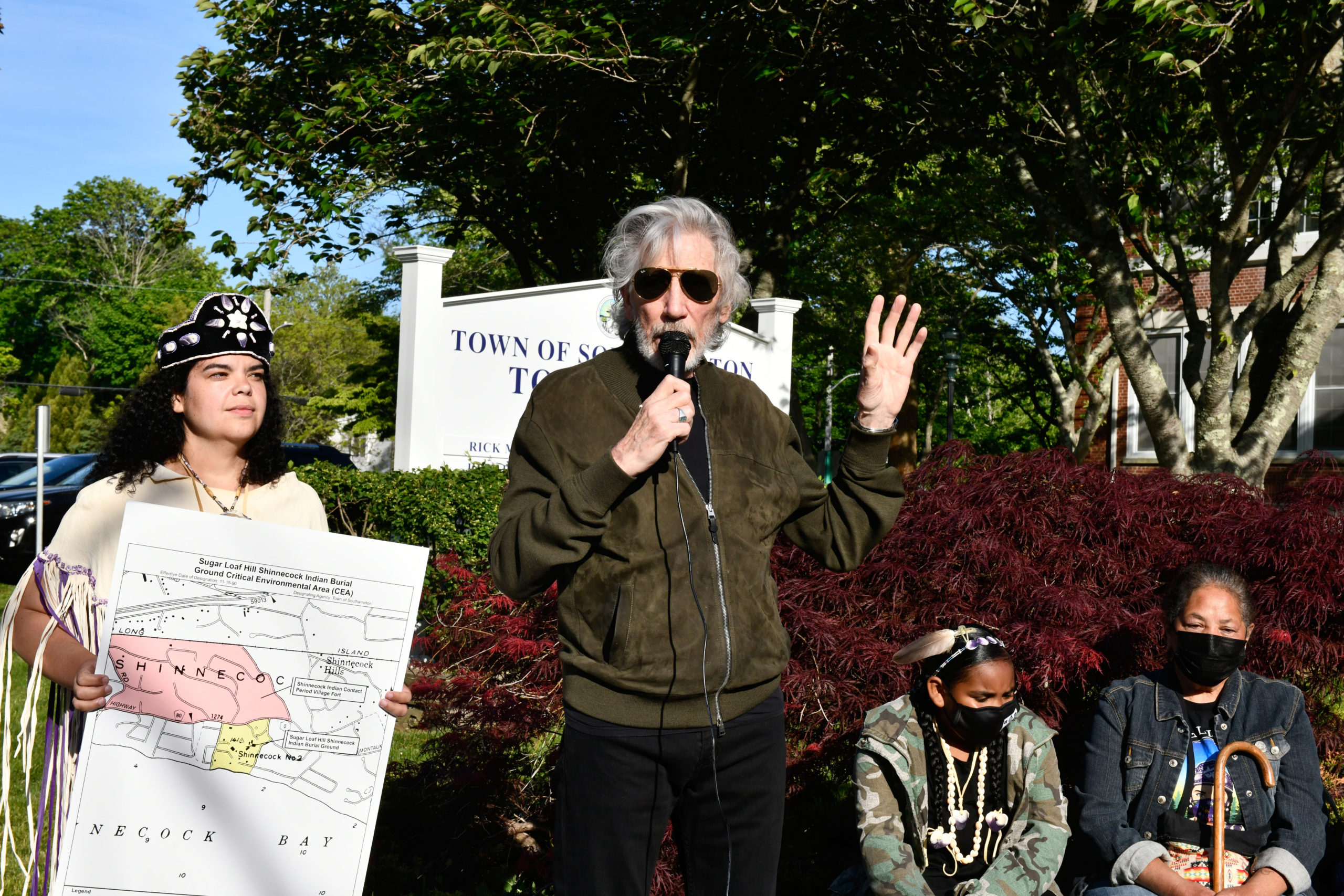
Members of the Shinnecock Nation and their friends and supporters gathered outside Southampton Town Hall Tuesday evening, May 25, singing songs, and listening to impromptu speeches calling for the Town Board to preserve a key parcel and ancient burial ground on the top of Sugar Loaf Hill in Shinnecock Hills.
Then, many of them filed into Town Hall, where they offered unanimous support at a public hearing for a plan that would have the town spend $5.3 million from the Community Preservation Fund to buy the development rights to the 4.7-acre parcel from the Peconic Land Trust, which is buying the land from its current owners, the Nappa family, and expects to close on the deal on June 15.
Although some called for the board to vote on the measure immediately, Supervisor Jay Schneiderman said that because of the lingering pandemic, he wanted to keep the record open for two weeks to give anyone who could not attend the meeting an opportunity to weigh in, adding that he expected the board to approve the purchase when it meets on June 8.
“This property is not just property to us,” Shinnecock Tribal Council Chairman Bryan Polite told the board. “It is a sacred burial site that has been there for almost 3,000 years.” He said that for decades, tribe members had suffered “historical trauma” by having their land desecrated and their ancestors’ remains disturbed or stolen.
Mr. Polite praised the Town Board for having “stepped up to the plate to try to right some of those historical injustices,” and said preserving the property would be another step in the right direction.
John v.H. Halsey, the president of the Peconic Land Trust, reminded the board, “that we are meeting this evening on the ancestral land of the Shinnecock people, who have lived here in this place for 8,000 to 10,000 years.” He said the Sugar Loaf property being targeted for acquisition had been disturbed since the 1930s, with remains and artifacts removed and a house built on it. “This is a unique opportunity to build greater trust between the town and the Shinnecock people,” he said, “and the Trust is honored to play a role in making this happen.”
Newly elected tribal Trustee Kelly Dennis told the board that Sugar Loaf’s cultural and spiritual value could not be overemphasized. “It really is and has been documented as the most significant Indian burial site in the State of New York,” she said. “This has been done by the New York State Museum and Science Service, and that is why it has been designated a critical environmental area.”
The rock musician and former member of Pink Floyd, Roger Waters, who has taken up the Shinnecock cause, also spoke. “I found myself deeply moved and somewhat in awe of the gravity — but also for the potential for joy — that is in front me today,” he said of the rally that preceded the hearing. “I will remember this day or the rest of my life because I think it is incredibly important to this community and all of us who are here and are lucky enough to be part of this.”
Well over 100 sets of remains have been returned to the tribe in recent years from museums and other institutions for reburial, said Shane Weeks, co-chairman of the Graves Protection Warrior Society of Shinnecock.
“We need to purchase, preserve, reclaim, and protect Sugar Loaf Hill and assure everlasting peace for our ancestors buried on those lands,” he said. “We hope our neighbors can understand and protect our traditions and our way of life.”
Support came from others in the community as well. Eamon Kobel, a resident of Westhampton, said the town had provided CPF money for the restoration of his home, the Topping Raynor House. “If my house can be protected, so should their land,” he said.
Kyle Solis, a resident of Amityville, pointed out that when he travels around Long Island, he often encounters the graves of colonial settlers that are well protected. Preserving Sugar Loaf would offer “a great opportunity for the rest of the people of Southampton to learn more about these wonderful people and learn their history,” he said.
Shinnecock attorney Tela Troge thanked the Town Board for adopting a graves protection law and imposing a moratorium on portions of Shinnecock Hills. But she said with a hot real estate market, developers were waiting for the moratorium to end so they could cash in.
“If we don’t work quickly, we are going to see the last vacant parcels in this area be developed,” she said. “This is a sacred 3,000-year-old burial ground. We are not going to have any more homes there, we’re not going to have any more swimming pools there, we’re not going to have any more tennis courts.”
Noting the overwhelming support for the purchase, Ms. Troge asked the board to vote immediately to heavy applause from those in attendance.
Mr. Schneiderman said he had visited the Sugar Hill site for the first time earlier in the day. “For those of you who are Shinnecock who’ve never had the opportunity to go to this place where your ancestors are buried, I don’t know what to say. It is an extraordinary place,” he said. “It’s hard not to be moved when you are there and not feel a sense of something very spiritual, very mystical. I understand why that site was chosen.”